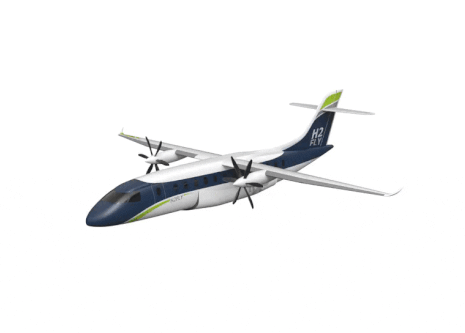German airlines H2Fly and Deutsche Aircraft are going to create a 40-seat hydrogen airliner. As reported by New Atlas, they plan to develop an aircraft by 2030. The liner will be able to fly up to 1,850 kilometers with a cruising speed of 520 kilometers per hour.
The International Civil Aviation Organization (IATA) has recommended that air carriers reduce their emissions of harmful substances by 50 percent by 2050 compared to the level of 2005. Faced with tougher environmental requirements, many companies have started creating electric and hybrid aircraft. Thus, the Airbus concern has launched the ZEROe project and is going to develop a hydrogen passenger aircraft by 2035.
Hydrogen-powered aircraft have more complex propulsion systems than fully electric ones. They are also driven by electric motors, but they receive electricity from a fuel cell, connecting hydrogen with oxygen on the move, which create an electric current due to redox processes. During this process, only water is released, so hydrogen aircraft are considered environmentally neutral.
The German company H2Fly has already created a four-seat HY4 hydrogen aircraft based on the Slovenian Pipistrel Taurus Electro G4. It first took off in 2016. The aircraft can reach speeds of up to 200 kilometers per hour and fly a distance of up to 1500 kilometers.
In July, H2Fly and Deutsche Aircraft announced that they were going to develop a 40-seat hydrogen passenger liner together. The companies claim that it will be the most powerful hydrogen aircraft in the world. They will build a technology demonstrator based on the Dornier 328 aircraft. Its turboprop twin-engine engine with a capacity of 1625 kilowatts will be replaced by a system on hydrogen fuel cells with a capacity of 1.5 thousand kilowatts. The first flight of the demonstrator is scheduled for 2025.
The hydrogen liner, designed for 40 passengers, should appear in 2030. It is assumed that its power plant will have a capacity of three megawatts. It will be able to fly up to 1,850 kilometers with a cruising speed of 520 kilometers per hour.
Other companies are also working on the creation of hydrogen passenger aircraft, including the Slovenian Pipistrel and the British-American ZeroAvia . The latter recently started developing a 19-seat aircraft.
Vasilisa Chernyavtseva

